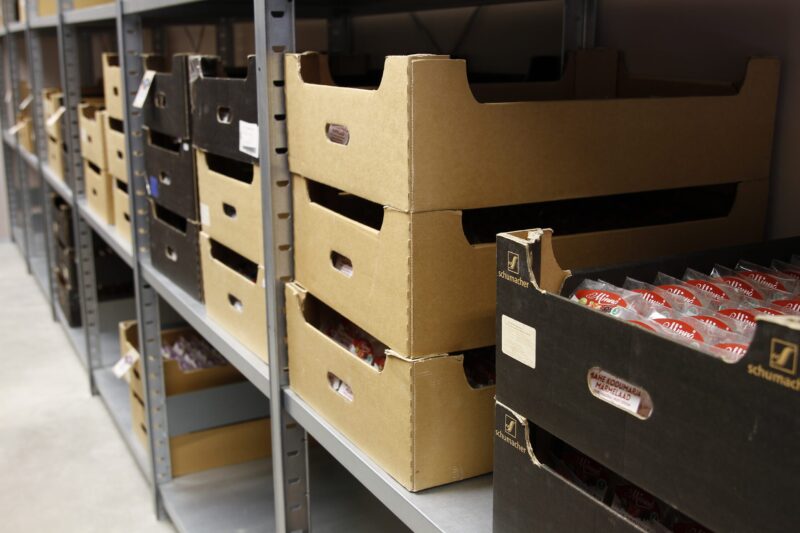The dead stock survival guide for manufacturers
“When there is no more room in inventory, the stock will flood the shop [floor].”
Firstly, we apologize to any George A. Romero fans who might be offended by the repurposing and rephrasing of that quote. Secondly, even though the quote originally referred to a less-than-convenient zombie outbreak, the sentiment still applies to inventory management. Today, we’re looking at the zombie equivalent of the manufacturing world — dead stock.
Cue lightning strikes ⚡⚡
Remember those horror stories you heard when you were growing up?
A young maiden haunts and terrorizes those who dare venture to the church after she was abandoned at the altar on her wedding day. Creepy — But more than likely, not true. However, like the unwed specter, sometimes an item doesn’t sell and is left abandoned on an unlit shelf in your warehouse.
And there, it survives by eating up space and devouring your company’s revenue.
You don’t need this zombie-esque product munching away behind your back, and that’s where this guide comes into play. Here you’ll learn the dead stock definition, how to exorcize it, and get more control over your inventory.
So, assuming you don’t want to get overrun by dead stock, let’s begin.
What is dead stock?

Dead stock is the accumulation of unsellable items.
There are several reasons why you end up building dead inventory:
- An item’s popularity
- An item has become obsolete
- Overzealously stocked too much inventory
- Bad inventory management means an item has been forgotten
- Denial that the item is not selling
Regardless of how the dead stock infestation occurred, it all leads to the same issues. Dead stock left unchecked occupies space for products that could be earning you “cha-ching” while also driving up carrying costs. Don’t kick yourself if you do have dead stock in inventory. Many companies discover a literal graveyard in their inventory.
Businesses without good inventory management systems are the most prone to gathering dead stock, leaving their products to become forgotten and even obsolete.
Dead Stock vs Deadstock
So, just to clear up any misunderstandings with the dead stock meaning:
- Dead Stock — Inventory that hasn’t been sold for an extended period
- Deadstock — Inventory that isn’t manufactured or stocked anymore and often comes with a premium price
Deadstock is a term mainly used by resellers. One man’s dead stock is another man’s deadstock. Try to avoid confusing the two when figuring out which one applies to you.
What causes dead inventory?

Most horror film dilemmas come from an issue that the protagonists either directly or indirectly caused:
- They fooled around with an Ouija board, and now demons are causing a ruckus
- They accidentally invited a vampire around for dinner, and now the bloodsucker has misunderstood what’s on the menu
- They wanted to create life but, whoopsie made a monster
The same can be said for dead stock, it’s created from a problem that might be obvious, not so obvious, or one that you’re actively ignoring — basically, it’s a problem that requires investigation.
Dead stock management will help you identify the root causes to tackle the problem.
So, the causes you should be keeping an eye on are:
1. Defective products
Something is wrong with your product, and it’s affecting sales. This could be due to poor quality, engineering, or design. Although this type of dead inventory is the least troublesome kind as simply repairing the product might resurrect it.
2. End of season or product life cycle
Are the products you make particularly popular during seasonal periods? Maybe you make products that are more popular during winter or make good gifts? It might be worth looking into the product’s life cycle to determine which stage a finished good is at.
3. Loss of a significant customer
Maybe you’ve lost a loyal customer (or two) or a contract, and this has greatly affected the sale of your products.
4. No demand
This is the hardest and, let’s be honest, saddest dead inventory to deal with.
Low demand could come from the product becoming less popular, a newer product has unfortunately rendered yours obsolete, or maybe you’ve overestimated how popular the product will be on the market.
The only thing you can do here is cut your losses and ditch the items as quickly as possible.
5. Denial
You’re not accepting reality and keeping products stocked even though it doesn’t ever leave with a customer.
It doesn’t have to be that your product isn’t in demand. It might just be that your pricing is too high. But, instead of lowering your prices, you assume that customers will eventually pay what you’re charging.
For example, desktops and laptops face this issue regularly. At first, the product might be a high-end device. But eventually, it will become outdated as technology improves. Charging at the original price may drive away sales as other options will be available for the customer.
If you want to avoid being a manufacturer who is in denial, try asking yourself this question when looking into your inventory:
“Are the benefits of holding the item better than simply freeing up space?”
Be warned! You might be mistakenly thinking that the inventory is not selling. However, it could be that the products are just slow-moving inventory (SMI) and not beyond hope.
One thing is investigating the underlying cause of death of a product, but what about prevention and what to do when you find dead stock?
Dead stock can cost businesses as much as 11% of their revenue. Here we help ambitious manufacturers identify and stop dead stock inventory from gathering.
A dead stock example in action

Imagine an artist who prints t-shirts with ghoulish-looking creatures on the front in anticipation of Halloween.
Fiendishly proud of the design, they go ahead and print the graphic on 200 shirts. Unfortunately, they’re a bit too gruesome for the public and largely go unsold. It’s coming up to Christmas now, and the artist still has 187 shirts in stock.
The artist had a lovely idea for a Christmas-themed shirt but only has space for 13 t-shirts.
Let’s perform some quick dead stock analysis to try and understand what the artist might investigate to figure out what went wrong. They:
- Didn’t do market research
- Misunderstood their target audience
- Didn’t invest enough in marketing
- Chose t-shirts when jumpers would have been better
- Overpriced the t-shirts
Figuring out what went wrong will prevent them from making the same mistake in the future. But what impact did this dead stock have on their business? Let’s investigate the cost of dead stock.
The artist had priced these t-shirts at $30 a pop. The’s $5,610 in revenue theoretically down the drain. That doesn’t include how much it costs to make or keep the t-shirts in storage.
Let’s say it was $10 to make one shirt. The artist is down:
$1,870
But now, this dead stock has been taking up inventory space. And to keep one t-shirt in storage costs the artist $0.05 a day. This means, from Halloween to Christmas, in carrying costs, the artist has lost a further:
$514.25
Nightmares like this do happen in the manufacturing world. However, accumulating dead stock is avoidable with a bit of work.
How to avoid dead stock

There are a few techniques you can try out when analyzing if inventory is dead or not.
These are:
1. Investment value
Do a quick calculation of your product’s investment value to determine if a product is or could become dead stock.
2. Shelf life
Maybe the items you sell only have a certain amount of time when they’re sellable, like perishable goods. Tracking these items means taking the appropriate action before it reaches their sell-by date.
3. Turnover
Looking at your turnover rate can help you identify surplus inventory and see the profit margin of your products.
4. Demand planning
The most pre-emptive thing you can do is forecast demand. By performing some demand planning, you can estimate the inventory level you need to meet customer demand from your forecast.
5. Survey customers
Why not ask your customers what they think about your products? They’re going to be brutally honest and help you identify any issues. Customer research allows you to avoid pushing products on gut instinct and will only improve your product’s performance.
6. Inventory management
This step is going to help your business eliminate dead inventory exponentially. Make and sell smaller quantities to monitor how well your products are performing. This will help you generate accurate demand forecasts and refine your inventory management skills.
However, suppose you implement cloud inventory software into your business. In that case, you won’t need to worry about performing these tasks yourself, as it will all be calculated for you on the software.
Without this software, dead stock can remain in inventory without going noticed, raising your storage costs, including:
- Rental costs of the warehouse
- Utilities
- Insurance
- Security
- Equipment
If you follow these steps carefully, you can quickly identify the current level of dead stock and decide how to best deal with this. By regularly monitoring your stock levels, you’ll be able to prevent dead inventory building in the future. This will also help improve profit margins on products and better determine what prices you should set for them.
So, that’s prevention, but when confronted face-to-face with dead stock, how do you survive this encounter?
How to get rid of dead stock

Thankfully, unlike horror films, dealing with dead inventory isn’t as grueling as having to destroy a zombie’s brain or throw a head of garlic at an approaching Dracula.
But the sooner you dispose of this parasite, the quicker your business’s health will improve.
So, what tactics can you use to sort this issue out?
1. Promotional deals
Discount. Fire Sale. Everything Must Go. Get it out of there as quickly as you can by lowering your prices!
2. Inventory kitting
You can try employing inventory kitting, often referred to as product bundling or cross-selling.
If the discounts still aren’t getting the customers to bite, maybe try bundling the dead stock alongside selling products. “Buy one and get one free” or packaging dead stock with other selling items, those sorts of deals.
Pro tip: Mystery boxes or parcels are ridiculously popular now. How about creating your own mystery box with several products to get rid of your dead stock?

3. Inventory on consignment
A retailer or wholesaler may do a better job if you cannot sell your inventory. See if arranging a consignment inventory agreement with another business to sell your products is possible.
4. Liquidation retailers
Liquidation retailers sell items at huge discounts or an auction. Businesses that are usually going into liquidation sell their assets through liquidation retailers but also accept unsellable inventory.
5. Charity
Charities will be more than happy to take the product off your hands, and it’ll be a good deed done! Also, depending on your tax jurisdictions, you might even be entitled to a tax write-off!
Look, most of these tactics will make your profit margin look disastrous. However, you’ll be able to recoup these losses by holding inventory that sells and saving on your carrying costs.
The objective regarding dead stock should be to get rid of it as soon as possible.
The end is nigh

What did we learn? Well, unlike an apocalyptic horror film, dead stock isn’t the end of the world.
Now that you know how to detect, prevent, and respond to dead stock you can immediately start recuperating that lost revenue.
But let’s just quickly reiterate the two major things you need to do to avoid storing it again in the future:
- Accept reality — If something isn’t selling, try and shift it out of your inventory using one of the methods above as soon as possible
- Arm yourself with inventory management software
Mistakes happen despite you and your employees’ efforts, inventory isn’t properly accounted for, and before you know it, you’ve built some dead stock again.
Katana inventory management software assists micro and SMB manufacturers get better visibility of stock movements with its real-time master planner. This means that available items in your inventory are automatically allocated to any open sales or manufacturing orders. With Katana, you’ll be able to get up-to-date reports on inventory movement and track them via your product SKU’s.
Production management software will help you determine when something isn’t performing well so you can begin making the relevant plans to phase out your dead stock — saving you the trouble of performing these investigations yourself and manually updating your Excel spreadsheets.
Get the breathing space you need to focus on growing your business with Katana.
Now, do you feel confident to take on that immobilized inventory? Feel free to pop us a message and let us know.
Until next time, happy manufacturing!
Table of contents
Inventory management guide
More guides from Katana
Get visibility over your sales and stock
Wave goodbye to uncertainty by using Katana Cloud Inventory for total inventory control






